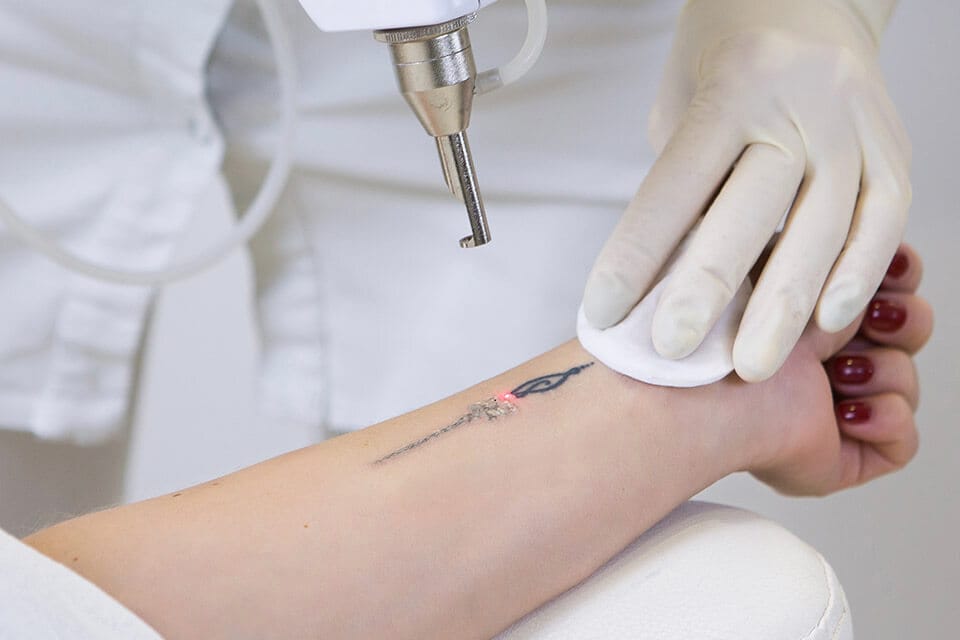- Thriving Guide
- Posts
- Understanding How Q-Switched Lasers Work
Understanding How Q-Switched Lasers Work
From tattoo removal to skin rejuvenation, this high-energy laser technology delivers powerful results with precision.

Once considered the gold standard for tattoo removal, Q-switched lasers have now expanded into a wide range of skincare and medical applications. These advanced lasers deliver quick bursts of concentrated light energy that can penetrate deep into the skin enough to shatter tattoo ink or excess pigment, yet gentle enough to treat delicate facial areas.
Today, Q-switched lasers are used to address everything from acne scars and wrinkles to spider veins and fungal infections. And with FDA approval for several applications, they’re regarded as both safe and effective when used by qualified providers.
Here’s how Q-switched lasers work and why they continue to be a go-to treatment in cosmetic dermatology.
How Q-Switched Lasers Work
Unlike lasers that emit a continuous beam, Q-switched lasers release ultra-short, high-intensity pulses of energy. This unique “Q-switching” mechanism makes them especially effective for breaking down pigmentation and tattoo ink without damaging surrounding skin.
Q-switched lasers operate at different wavelengths, with the two most common being:
1064 nanometers (nm): Targets deeper pigments like black and dark blue
532 nm: Best for red, green, and light blue pigments or superficial skin discoloration
These lasers come in different types, such as Nd:YAG, Ruby, and Alexandrite, each suited for specific treatments and skin types.
Top Uses for Q-Switched Lasers
Thanks to their versatility, Q-switched lasers are used for a variety of skin concerns and cosmetic goals:
Tattoo Removal
Q-switched lasers remain the leading non-surgical option for tattoo removal. The laser targets ink particles, breaking them into fragments that are gradually flushed out by the body’s lymphatic system. Results vary based on tattoo color, depth, and age. Black tattoos respond best to 1064 nm wavelengths, while colored tattoos may require multiple settings and sessions.Hyperpigmentation Treatment
Whether it’s melasma, sun spots, lentigines, or café-au-lait patches, Q-switched lasers can target excess melanin. The laser breaks down the pigment, allowing the body to naturally eliminate it. Studies have shown a success rate of up to 79% for treating café-au-lait spots in children using Q-switched lasers.Spider Veins and Vascular Lesions
Spider angiomas and other superficial blood vessels respond well to Q-switched laser therapy. The laser shrinks dilated blood vessels, reducing their appearance without surgery.Skin Rejuvenation and Resurfacing
Q-switched lasers can improve skin tone and texture, reduce wrinkles, minimize pores, and lighten dark under-eye circles. One study found a 54% reduction in blood loss during Q-switched laser liposuction compared to traditional methods, highlighting its minimally invasive benefits.Acne Scar Treatment
Clinical trials show significant improvements in acne scarring with 1064 nm Q-switched laser treatments. Most patients experience results within three sessions, spaced eight weeks apart, with minimal side effects.Fungal Infections
Q-switched lasers are even being used to treat conditions like onychomycosis (toenail fungus) and athlete’s foot by targeting fungal cells without damaging the surrounding tissue.Hair Reduction
While not the first choice for laser hair removal, Q-switched lasers are FDA-approved for lightening or removing hair, especially in small or delicate treatment areas.
What to Expect Before and After Treatment
Before any laser session, you'll meet with a dermatologist or laser specialist for a consultation. They’ll assess your skin type, medical history, and treatment goals. You may be advised to avoid exfoliants, retinoids, or sun exposure leading up to the session.
During treatment:
A numbing cream or local anesthetic may be applied
You’ll wear protective eyewear
A test spot may be performed to check skin response
Sessions typically last 10 to 45 minutes depending on the treatment area
Aftercare is essential:
Keep the treated area clean and covered for 24–48 hours
Avoid sun exposure, soaking, or scratching the area
Apply antiseptic or antibiotic ointment as instructed
Most people resume normal activities quickly, although some redness, swelling, or mild discomfort is normal in the first few days.
Potential Side Effects and Precautions
When performed by trained professionals, Q-switched laser procedures are generally safe. However, possible side effects include:
Temporary redness or swelling
Hyperpigmentation (especially if sessions are too close together)
Bruising or itching
Rare allergic reaction to broken-down tattoo ink
Slight risk of scarring
Q-switched lasers should not be used on skin with active infections. They may also trigger herpes outbreaks in individuals with a history of the virus, so pre-treatment antiviral medications might be recommended.
Is It Right for You?
Q-switched lasers offer a precise, minimally invasive approach to a wide range of skin concerns. Whether you’re looking to fade a tattoo, brighten dark spots, or reduce scarring, this technology can deliver real results with little downtime.
However, multiple sessions may be necessary depending on your goals, and full clearance (especially with tattoos or deep pigmentation) isn’t always guaranteed. As always, consult a licensed provider to determine the best course of treatment for your needs.
If you found this article helpful, share it or subscribe to our newsletter for more skincare and wellness insights.